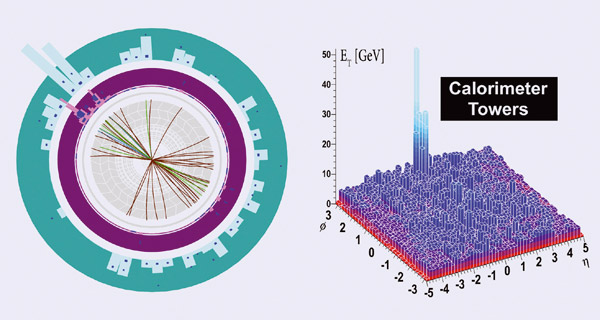
The ATLAS experiment has made the first observation of an unexpectedly large imbalance of energy in pairs of jets created in lead-ion collisions at the LHC (G Aad et al. 2010). This striking effect, which is not seen in proton–proton collisions, may be a sign of strong interactions between jets and a hot, dense medium (quark-gluon plasma) formed by the colliding ions.
Concentrated jets of particles are formed in the head-on (central) collisions of lead ions at the LHC. The jets materialize from the hadronization of quarks and gluons scattered from the protons and neutrons in the colliding ions. If a quark-gluon plasma is formed in the collisions of the high-energy ions, then as the jets materialize they will traverse this hot, dense medium. In so doing they should lose energy to the medium through multiple interactions, in a process called jet quenching.
The jets are most often produced in pairs (dijets) travelling in opposite directions with equal transverse energies, but if the jets travel different distances before escaping the medium, then their energies will no longer be equal. Experiments at the Relativistic Heavy Ion Collider at Brookhaven observed signs of this effect in single-particle distributions; however, the result from ATLAS represents the first direct observation of energy loss by jets, and the first in which the effect is visible on an event-by-event basis (figure 1).
The excellent angular coverage, segmentation and energy resolution of its calorimeters make ATLAS well suited to measuring jets. For this analysis, the collaboration looked at a sample of 1693 events with at least one jet having transverse energy greater than 100 GeV. They then characterized the difference in energy in the dijets by the ratio of the difference of the jet energies to the sum of the energies. In studying this dijet asymmetry ratio they found that it varies as a function of the centrality of the colliding nuclei, as figure 2 shows, where the fraction of events with a given asymmetry is plotted versus the measured asymmetry for four different ranges of centrality, the most central events in the plot at the right and the least central at the left.

The plots show the asymmetry for lead-ion collisions at 2.76 TeV/nucleon in the centre-of-mass and for 7 TeV proton–proton collisions together with the prediction from a Monte Carlo simulation that does not include interactions between the jets and the medium. The measured asymmetry clearly increases with centrality: the distribution broadens and the mean shifts to higher values. To confirm the effect, the collaboration performed numerous studies to verify that events with large asymmetry are not produced by energy fluctuations, background, or detector effects.
The observation of this centrality-dependent dijet asymmetry by ATLAS has a natural interpretation in terms of QCD energy loss and may point to a strong energy loss by the jets in the quark-gluon plasma. The asymmetry has also been reported by the CMS collaboration and a related effect in single particle distributions has been reported by the ALICE collaboration, at a seminar at CERN together with ATLAS on 2 December. The result, together with others presented at the seminar, marks the beginning of a broad and exciting programme of heavy-ion physics at the LHC.








